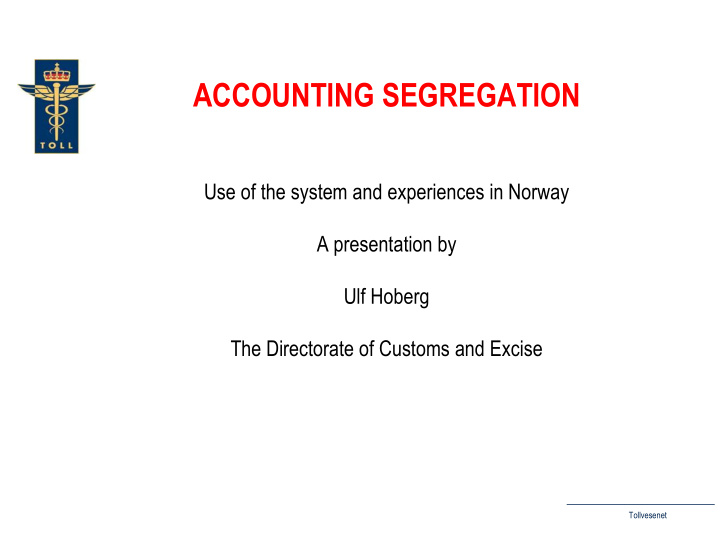



ACCOUNTING SEGREGATION Use of the system and experiences in Norway A presentation by Ulf Hoberg The Directorate of Customs and Excise Tollvesenet
ACCOUNTING SEGREGATION OR THE USE OF FUNGIBLE MATERIALS MEANING THE STORAGE AND USE OF IDENTICAL MATERIALS WITH DIFFERENT ORIGIN FOR THE MANUFACTURE OF ORIGINATING PRODUCTS. Tollvesenet
ACCOUNTING SEGREGATION • ONLY FOR MATERIALS TO BE USED IN PRODUCTION • ACCOUNTING SEGREGATION IS NOT ALLOWED FOR FINISHED PRODUCTS • ACCOUNTING SEGREGATION REQUIRES A SEPARATE ACCOUNTING SYSTEM , but it must be connected with the economic accounting system Tollvesenet
ACCOUNTING SEGREGATION Where considerable cost or material difficulties arise in keeping separate stocks of originating and non-originating materials which are identical and interchangeable, the customs authorities may, at the written request of those concerned, authorise the so-called 'accounting segregation' method to be used for managing such stocks. Tollvesenet
ACCOUNTING SEGREGATION – conditions for the use of the system • The applicant must demonstrate a need to use accounting segregation on the grounds of unreasonable costs or impracticability of holding stocks of materials physically separate according to origin. • The originating and non-originating materials must be of the same kind and commercial quality and possess the same technical and physical characteristics. It must not be possible to distinguish materials one from another for origin purposes once they are incorporated into the finished product. Tollvesenet
ACCOUNTING SEGREGATION – conditions for the use of the system • The originating and non-originating materials must be of the same kind and commercial quality and possess the same technical and physical characteristics. It must not be possible to distinguish materials one from another for origin purposes once they are incorporated into the finished product. • The use of the system of accounting segregation shall not give rise to more products acquiring originating status that would have been the case had the materials used in the manufacture been physically segregated. Tollvesenet
ACCOUNTING SEGREGATION – the accounting system The accounting system must: - maintain a clear distinction between the quantities of originating and non-originating materials acquired, showing the dates on which those materials were placed in stock and, where necessary, the values of those materials; - show the quantity of: (a) originating and non-originating materials used and, where necessary, the total value of those materials; (b) finished products manufactured; (c) finished products supplied to all customers, identifying separately, (i) supplies to customers requiring evidence of preferential origin (including sales to customers requiring evidence other than in the form of a proof of origin), and (ii) supplies to customers not requiring such evidence; - be capable of demonstrating either at the time of manufacture or at the time of issue of any proof of origin (or other evidence of originating status), that stocks of originating materials were deemed available, according to the accounts, in sufficient quantity to support the declaration of originating status. Tollvesenet
ACCOUNTING SEGREGATION in Norway • 7 companies use the system – all of them in the fish and seafood manufacturing business. • On 1 February 2007 new regulations were introduced and all users of accounting segregation had to apply for new authorizations • Before 1 February 2007 we had more than 70 companies using the system (50 in the fisheries and 20 other industries). Tollvesenet
Tollvesenet
Tollvesenet
Tollvesenet
Recommend
More recommend